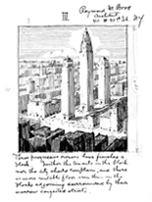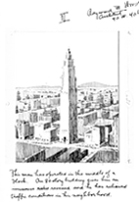Shawn Nevers
English 1101
Prof. Matthew Gold
12/13/2012
The Glorious Rockefeller Center
The Rockefeller Center is one the world’s most illustrious structures. Built in 1930 and completed by 1939, the Rockefeller Center is not just one of New York’s cynosure sites it also is one of America’s omphalos structures. This noteworthy building was sponsored by the notorious John D. Rockefeller Jr. and designed by Raymond Hood and a bundle of architects. The Rockefeller Center was another way to emphasize the eminence of the Rockefeller’s. Before the birth of the Rockefeller Center, the structure that lived there was Columbia University until the Stock Market Crash the area was completely leased by Rockefeller Jr.. The area initially was going to be turned into an opera house but because of the strength of the stock market crash it enticed Rockefeller Jr. to move forward and create a skyscraper. The funding for this structured was approximately $250,000,000 which was an extraordinary amount of money in the 1930’s. The Rockefeller Center is absolutely effervescent.
My own experiences at lead me to believe that this structure is a bit more idiosyncratic over other skyscraping structures. In my early childhood, I would visit the Rockefeller Center every June, October, November, and December. My favorite time was in December because the Rockefeller Center was absolutely celestial during the holidays and I was always able to entice my parents into taking my sister and me there. When I visited other structures such as the empire state building the only thought that I felt were aesthetic and historic. As I approached the Rockefeller Center I felt and endless amount of thoughts like pulchritudinous, miscellaneous, and harmonious. The Rockefeller center is a prime example of a truly unique skyscraper. In James Murray‘s work The Architect and the Skyscraper he states that a skyscraper “is anything that makes you stop, stand, crane your neck back, and look up (3). Skyscrapers have that characteristic but what about the senses that you feel or what happens to you as you approach this structure? Is it a structure that plays with your mind or is just an extremely tall structure that looks the meet a city’s zoning limit? Zoning gave each city a different stereotypical skyscraper making each city look unique (4). In 1916, New York changed the way its skyscrapers would look for good by passing its first zoning limit (9). The zoning law forced cities to build structures to a certain height. The Rockefeller Center doesn’t need to be a skyscraper to look aesthetic but zoning laws limit and take away what a structure can develop into. For example, a structure that exceeds the zoning limits is Burj Dubai in Dubai. It developed into a very complex structure because it exceeded the zoning limits. Murray said “New York made people think of skyscrapers as prestigious but in fact shorter building can have just as much impact” (21). The Rockefeller Center isn’t the tallest structure in the world but it captures the essence of a skyscraper and even more because it attracts people from the different parts of the world and its public relations draw publicity.
Skyscrapers have become a accustomed to people throughout the world. Even though the Rockefeller Center was one of America’s oldest skyscrapers and being that America was the first country to start the era of skyscraping other countries have created structures that can match the effectiveness of skyscraper here in America. In the novel Skyscrapers of the Future by Carlo Aiello, Aiello allows journalist to talk about different skyscrapers in different countries. Two of the journalists were Brian Ahmes and Chad Porter; they were talking about one of the most statuesque in Southern Asia the “Grand Metropolis.” Much like the Rockefeller Center the Grand Metropolis serves as center Piece in Asia. It also is a site that attracts an endless amount of tourist and brings in plenty of money due to its complexity. This structure also brings in different thoughts and characteristics that make an “out of the box” project. Ahmes and Porter said “at first glance, this tower echoes a typical building in its constructional phase (22)”. This is what makes the structure unique if it is able to affect your senses and you can appreciate the building in a way that makes it feel more than just some everyday structure. Further down Ahmes and Porter said “moving up the tower’s podium, exposed detailed sections reveal overlapping floors and roofs from above and below (22)”. Some structure don’t really affect like their supposed to but this one peculiar building brings a sense of imagery. When I look at the Grand Metropolis its looks like a Twizzler that’s standing on its own and that is structure that is worth preserving.
Here is an image of the construction workers building the Rockefeller Center. By looking at this image one can say that the skyscrapers in the 19th century were unbelievably cautious to the workers’ health. This image says that the designers of this structure were very determined, focused, and talented. Today the majority of construction and planning goes the technology but these workers are especially gifted because the average construction worker today wouldn’t go such depths such as death to create a skyscraper. This is also another image of the Rockefeller Center from the 1930’s. There is a difference from the Rockefeller Center in the 1930’s and Rockefeller Center we all know today. The neighborhood has drastically changed and become more technological. However, the building itself stand unchanged and its looks preserved.
The head leading architect for this edifice is Raymond Hood. Hood was already famous in the world of architecture: previously he along with his peers constructed the Chicago Tribune Tower and the American Radiator Building, Mcgraw-Hill Building, and the Daily News Building. Hood was a brilliant architect and solidified his name in American architecture because he and the other architects like Wallace Harrison not only created a structure that is beloved by America. Hood worked mostly in Art-Deco style and was a student at MIT an Ecole des Beaux-Arts in Paris. In the library journal news article in August 1982, there was a small section on Raymond Hood. The article said hood captured and had a big contribution on metropolitan culture back in the 1920’s. During that time Hood was a part of a competition in making the best tribune tower which he had won.
This is a picture of Hood’s sketches and this is his thought process of one of his structures till he reached phase 3 where he was satisfied with what he drew. Hood loved towers it was no surprise that he was the head leader of the Rockefeller Center project. He had different techniques that separated him from the pack of architect during his time. He had a theory on limiting the amount of volume based on the frontage of the streets. His theory turned out to be a huge success this allowed rentable space, more light and air for the tower’s occupants and plenty of street space for the public. Hood wasn’t just an architect he was a true visionary.
The Rockefeller Center is a pompous structure. It isn’t like other skyscrapers; it’s dovetailed, variegated, and animated. The Rockefeller Center is one of the reasons why people call New York City “the city that never sleeps.” My experiences with the Rockefeller Center up to my adolescence has made me understand why it was built in the neighborhood that it was built, why was it sponsored by Rockefeller Jr., why was Hood chosen as the leader to create this structure and why is it one of the focal points of the United States. It was another example to show the wealth, power, and influence of the Rockefeller clan. This design should became a national landmark sooner than in 1987 because this structure resembles the struggles and hardships of United States such as the Cold War, Great Depression, Stock Market Crash, Cuban Missile Crisis, and Civil Rights movement. The Rockefeller Center is space worth canning.
http://www.skyscraper.org/EXHIBITIONS/FUTURE_CITY/NEW_YORK_MODERN/walkthrough_hood.php
Journal Library, Raymond Hood, August 1982
Murray, John. The Architect and the Skyscraper, (Think James Photo, Jan 2012), 27
http://Polis-City.de/polis/media/downloads/pdf/03chicago.pdf
Aiello, Carlo. Skyscrapers of the Future, (I ngram DV LLC, Jan 2010), 200
http://www.rockefellercenter.com/art-and-history/history/1930s/
http://www.rockefellergroup.com/history/history.html
http://en.wikipedia.org/wiki/Rockefeller_Center
.







